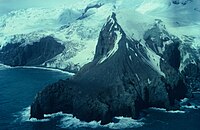
Radioteletype (RTTY) is a telecommunications system consisting originally of two or more electromechanical teleprinters in different locations connected by radio rather than a wired link. Radioteletype evolved from earlier landline teleprinter operations that began in the mid-1800s. The US Navy Department successfully tested printing telegraphy between an airplane and ground radio station in 1922. Later that year, the Radio Corporation of America successfully tested printing telegraphy via their Chatham, Massachusetts, radio station to the R.M.S. Majestic. Commercial RTTY systems were in active service between San Francisco and Honolulu as early as April 1932 and between San Francisco and New York City by 1934. The US military used radioteletype in the 1930s and expanded this usage during World War II. From the 1980s, teleprinters were replaced by personal computers (PCs) running software to emulate teleprinters.

Peter I Island is an uninhabited volcanic island in the Bellingshausen Sea, 450 kilometres (240 nmi) from continental Antarctica. It is claimed as a dependency of Norway and, along with Bouvet Island and Queen Maud Land, composes one of the three Norwegian dependent territories in the Antarctic and Subantarctic. The island measures approximately 11 by 19 kilometres, with an area of 156 km2 (60 sq mi); its highest point is the ultra-prominent, 1,640-metre-tall (5,380 ft) Lars Christensen Peak. Nearly all the island is covered by a glacier, and it is surrounded most of the year by pack ice, making it inaccessible during these times. There is little vertebrate animal life on the island, apart from some seabirds and seals.
The American Radio Relay League (ARRL) is the largest membership association of amateur radio enthusiasts in the United States. ARRL is a non-profit organization, and was co-founded on April 6, 1914, by Hiram Percy Maxim and Clarence D. Tuska of Hartford, Connecticut. The ARRL represents the interests of amateur radio operators before federal regulatory bodies, provides technical advice and assistance to amateur radio enthusiasts, supports a number of educational programs and sponsors emergency communications service throughout the country. The ARRL has approximately 161,000 members. In addition to members in the US, the organization claims over 7,000 members in other countries. The ARRL publishes many books and a monthly membership journal called QST.
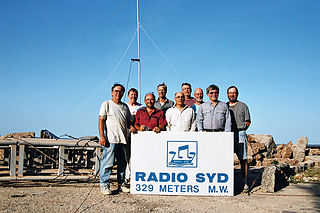
A DX-pedition is an expedition to what is considered an exotic place by amateur radio operators and DX listeners, typically because of its remoteness, access restrictions, or simply because there are very few radio amateurs active from that place. This could be an island, a country, or even a particular spot on a geographical grid. DX is a telegraphic shorthand for "distance" or "distant".

Field Day is an annual amateur radio exercise, widely sponsored by IARU regions and member organizations, encouraging emergency communications preparedness among amateur radio operators. In the United States, it is typically the largest single emergency preparedness exercise in the country, with over 30,000 operators participating each year. Field Day is always the fourth full weekend of June, beginning at 18:00 UTC Saturday and running through 20:59 UTC Sunday.
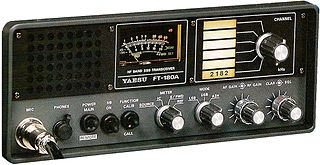
Yaesu is a Japanese brand of commercial and amateur radio equipment, founded as Yaesu Musen Co., Ltd. in 1959 by a Japanese radio amateur Sako Hasegawa, with call sign JA1MP, in the Tokyo neighborhood of Yaesu,
DXing is the hobby of receiving and identifying distant radio or television signals, or making two-way radio contact with distant stations in amateur radio, citizens' band radio or other two-way radio communications. Many DXers also attempt to obtain written verifications of reception or contact, sometimes referred to as "QSLs" or "veries". The name of the hobby comes from DX, telegraphic shorthand for "distance" or "distant".

Contesting is a competitive activity pursued by amateur radio operators. In a contest, an amateur radio station, which may be operated by an individual or a team, seeks to contact as many other amateur radio stations as possible in a given period of time and exchange information. Rules for each competition define the amateur radio bands, the mode of communication that may be used, and the kind of information that must be exchanged. The contacts made during the contest contribute to a score by which stations are ranked. Contest sponsors publish the results in magazines and on web sites.
Amateur radio frequency allocation is done by national telecommunication authorities. Globally, the International Telecommunication Union (ITU) oversees how much radio spectrum is set aside for amateur radio transmissions. Individual amateur stations are free to use any frequency within authorized frequency ranges; authorized bands may vary by the class of the station license.

Amateur radio international reciprocal operating agreements permit amateur radio operators (hams) from one country to operate a station whilst traveling in another without the need to obtain additional licenses or permits.

In times of crisis and natural disasters, amateur radio is often used as a means of emergency communication when wireline, cell phones and other conventional means of communications fail.

In the United States, amateur radio licensing is governed by the Federal Communications Commission (FCC). Licenses to operate amateur stations for personal use are granted to individuals of any age once they demonstrate an understanding of both pertinent FCC regulations and knowledge of radio station operation and safety considerations. Applicants as young as five years old have passed examinations and were granted licenses.
The World Administrative Radio Conference (WARC) bands are three portions of the shortwave radio spectrum used by licensed and/or certified amateur radio operators. They consist of 30 meters (10.100–10.150 MHz), 17 meters (18.068–18.168 MHz) and 12 meters (24.890–24.990 MHz). They were named after the World Administrative Radio Conference, which in 1979 created a worldwide allocation of these bands for amateur use. The bands were opened for use in the early 1980s. Due to their relatively small bandwidth of 100 kHz or less, there is a gentlemen's agreement that the WARC bands may not be used for general contesting. This agreement has been codified in official recommendations, such as the IARU Region 1 HF Manager's Handbook, which states: "Contest activity shall not take place on the 5, 10, 18 and 24 MHz bands."
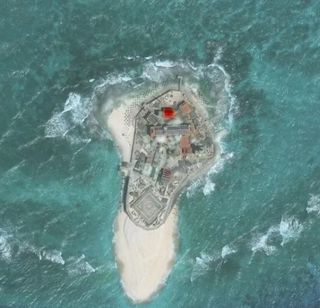
Amboyna Cay, also known as Vietnamese: Đảo An Bang; Malay: Pulau Amboyna Kecil; Datu Kalantiaw Island ; Mandarin Chinese: 安波沙洲; pinyin: Ānbō Shāzhōu, and other names, is an island of the Spratly Islands group in the South China Sea located just outside (SW) of the southwest of Dangerous Ground. It is SW of Barque Canada Reef, south of the London Reefs, and NW of Swallow Reef.
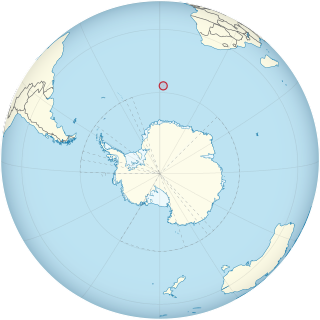
Bouvet Island is an island and dependency of Norway, and declared an uninhabited protected nature reserve. It is a subantarctic volcanic island, situated in the South Atlantic Ocean at the southern end of the Mid-Atlantic Ridge, making it the world's most remote island. It is not part of the southern region covered by the Antarctic Treaty System.
An amateur radio net, or simply ham net, is an "on-the-air" gathering of amateur radio operators. Most nets convene on a regular schedule and specific frequency, and are organized for a particular purpose, such as relaying messages, discussing a common topic of interest, in severe weather, emergencies, or simply as a regular gathering of friends for conversation.
Call signs in Korea are unique identifiers for telecommunications and broadcasting on the Korean peninsula. Call signs are regulated internationally by the ITU as well as nationally in South Korea by the Korea Communications Commission in the Ministry of Information and Communication. Not much is known outside of North Korea how amateur radio is regulated, although a foreign amateur was asked to appear before the "Radio Regulation Board" in 2002. Also, North Korea's Cultural Relations with Foreign Countries recently issued an operating permit, which was countermanded by the Ministry of Telecommunications and Posts.
Call signs in Antarctica include a three letter region code and a series of numbers and letters.

PSK Reporter is an amateur radio signal reporting and spotting network and website started by Philip Gladstone in 2014 which allows operators to see where their radio signals are being received. The platform works by collecting digital signal reports from software clients such as WSJT and FLDIGI then mapping them to show which stations are being heard by other clients. The website takes its name from the popular amateur radio digital mode PSK31 and supports numerous digital modes, but now a vast majority of digital modes recorded by the service are FT8 traffic. Most traffic recorded on PSK Reporter is in the HF amateur radio bands but the platform also supports MF, VHF, and UHF bands. As of 2021 PSK Reporter has collected over 20 billion reception reports.

